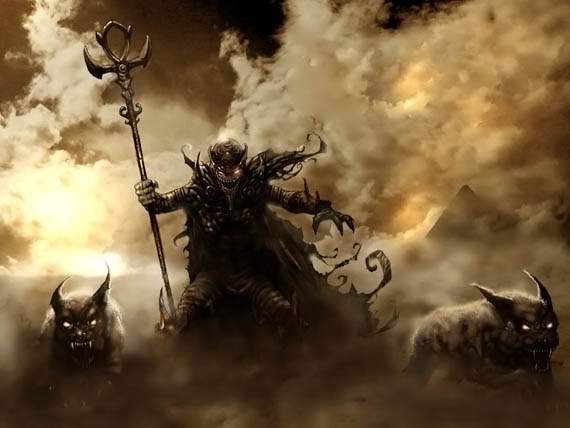Ada seorang rakan meminta saya mencari info mengenai kisah kaum ini dan disiarkan di blog Jom Kenal Islam ini.Saya harap info2 di bawah dapat membantu dia,anda semua serta diri saya mendalami ilmu Islam dengan lebih bersungguh-sungguh dan istiqamah.
Saya percaya, hampir kesemua pembaca blog ini telah acap kali mendengar mengenai perihal bangsa Yakjuj dan Makjuj atau di dalam bahasa inggeris-nya disebut sebagai Gog and Magog. Ia merupakan salah satu daripada 10 tanda-tanda besar kiamat. Untuk entri kali ini saya akan menerangkan secara amat terperinci mengenai bangsa Yakjuj dan Makjuj berlandaskan pelbagai sumber rujukan dan pandangan ulama’ tersohor. Di harap entri saya pada kali ini dapatlah dijadikan sebagai ilmu yang sangat bermanfaat buat anda semua.
Yakjuj dan Makjuj adalah dua bangsa manusia yang akan muncul ketika dunia hampir kiamat untuk melakukan kejahatan dan kerosakan dasyat di muka bumi ini. Bangsa-bangsa ini dikatakan telah wujud sejak ribuan tahun lalu tetapi mereka dikurung di suatu lokasi rahsia oleh seorang pemerintah silam iaitu Zulkarnain. Sejak dikurung di lokasi tersebut, mereka terus hidup dari satu keturunan hingga ke keturunan yang lain sehinggalah tibanya waktu pembebasan mereka iaitu menjelang hari kiamat.
Sejak kewujudan bangsa-bangsa tersebut di ketahui umum, pengkaji terus-menerus mencari jawapan kepada pelbagai persoalan mengenai kehidupan mereka serta lokasi misteri yang mengurungi bangsa tersebut. Siapa sangka di sebalik kemajuan ketamadunan yang menghasilkan banyak bandar-bandar besar dibina di seluruh dunia, masih wujud bangsa misteri di satu lokasi yang menjadi ‘pusat tahanan’ Yakjuj dan Makjuj dan lokasi itu telah pun berjaya dijumpai pada hari ini bersama benteng atau temboknya.
Sifat dan ciri-ciri bangsa Yakjuj dan Makjuj bukanlah seperti mana yang di gempar-gempurkan oleh masyarakat barat (contohnya seperti illutrasi di atas). Sebagai orang Islam kita wajib mengkajinya berlandaskan Al-Quran dan Hadis.

Dalil Al Quran mengenai Yakjuj dan Makjuj
Kewujudan Yakjuj dan Makjuj adalah suatu yang pasti dan wajib diimani oleh seluruh umat Islam berdasarkan tanda-tanda besar sebelum tibanya hari kiamat. Kewujudan bangsa ini diceritakan sendiri oleh Allah swt menerusi firman-Nya di dalam kitab suci Al-Quran. Antaranya, menerusi surah al-kahfi, ayat ke-92 hingga 98, Allah swt berfirman:
Sehingga apabila ia sampai di antara dua gunung, ia dapati di sisinya satu kaum yang hampir-hampir mereka (Zulkarnain) tidak dapat memahami perkataan.
Mereka berkata: “Wahai Zulkarnain, sesungguhnya kaum Yakjuj dan Makjuj sentiasa melakukan kerosakan di bumi; oleh itu, setujukah kiranya kami menentukan sejumlah bayaran kepadamu (dari hasil pendapatan kami) dengan syarat engkau membina sebuah tembok di antara kami dengan mereka?”
Dia menjawab: “(kekuasaan dan kekayaan) yang Tuhanku jadikan daku menguasainya, lebih baik (dari bayaran kamu); oleh itu bantulah daku dengan tenaga (kamu beramai-ramai) aku akan bina antara kamu dengan mereka sebuah tembok penutup yang kukuh.
Bawalah kepadaku ketul-ketul besi”; sehingga apabila ia terkumpul separas tingginya menutup lapangan antara dua gunung itu, dia pun perintahkan mereka membakarnya dengan berkata: “Tiuplah dengan alat alat kamu” sehingga apabila ia menjadikannya merah menyala seperti api, berkatalah dia: “Bawalah tembaga cair supaya aku tuangkan atasnya”. Maka mereka tidak dapat memanjat tembok itu, dan mereka juga tidak dapat menebuknya.
(Setelah itu) berkatalahZulkarnain: “Ini ialah suatu rahmat dari Tuhanku; dalam pada itu, apabila sampai janji Tuhanku, Dia akan menjadikan tembok itu hancur lebur, dan adalah janji Tuhanku itu benar”.

Setelah dikurung oleh Zulkarnain, Allah swt menceritakan pula mengenai kebangkitan bangsa Yakjuj dan Makjuj, pada hari-hari terakhir dunia sebelum kiamat. Yakjuj dan Makjuj akan turun ke dunia melalui puncak-puncak gunung tinggi. Menerusi surah al-Anbiyaa’, ayat ke-96 dan 97, Allah swt berfirman:
(Demikianlah keadaan mereka) hingga apabila terbuka tembok yang menyekat Yakjuj dan Makjuj, serta mereka meluru turun dari tiap-tiap tempat yang tinggi.
Dan hampirlah datangnya janji hari kiamat yang benar, maka dengan serta-merta pandangan mata orang-orang yang kufur ingkar terbeliak (sambil berkata dengan cemas): “Aduhai celakanya Kami. Sesungguhnya kami telah tinggal dalam keadaan yang melalaikan kami daripada memikirkan perkara ini, bahkan kami telah menjadi orang-orang yang menganiaya diri sendiri”.
Tembok Yakjuj Dan Makjuj Telah Terbuka
(“…Maka mereka… tidak dapat menebuknya…”; al-Kahfi:97) Ayat ini telah menyatakan bahawa mereka tidak dapat menebuk tembok tersebut. Beribu-ribu tahun Allah swt memelihara tembok tersebut dan tiada sesiapa pun yang mampu menebuk tembok itu melainkan apabila Allah swt mengizinkan Yakjuj dan Makjuj dilepaskan.
Sebaliknya, di dalam satu hadis pula ada menceritakan iaitu Nabi bangkit dari tidur (dalam satu riwayat yang lain, Nabi masuk ke rumah Zainab binti Jahsyi), lalu berkata, “Celakalah Arab kerana kejahatan telah hampir. Yakjuj dan Makjuj telah menembusi tembok seluas ini!” Nabi mengisyaratkan lubang dengan menemukan ibu jari dan jari telunjuk.
Cuba kita perhatikan, hadis diatas ini telah menyatakan bahawa tembok itu “telah pun ditembusi” tetapi bagaimana pula dengan ayat 97 surah al-Kahfi yang menyatakan bahawa Yakjuj dan Makjuj “tidak dapat menebuknya”? Makna terhadap ayat 97 surah al-Kahfi ini adalah, tiada satu makhluk pun di seluruh alam ini mampu menebuk tembok tersebut kecuali dengan keizinan Allah swt manakala makna hadis diatas pula adalah, Allah swt telah pun melepaskan mereka dan mereka telah pun berjaya menebuk tembok tersebut melalui keizinan Allah swt. Kesimpulannya ialah, bangsa Yakjuj dan Makjuj sudah lama terlepas keluar ke dunia luar! (segala kebenarannya hanyalah milik Allah swt).
Bencana Di Sebalik Gunung
Puncak gunung yang dikatakan sebagai tempat Yakjuj Makjuj akan turun di akhir zaman nanti adalah di pergunungan Caucasus dan juga banjaran-banjaran tinggi di sekitar Mongolia, Kazakhstan dan juga Russia Selatan contohnya seperti banjaran Himalaya, Tien Shan, Elbruz, dan lain-lain. Banjaran-banjaran yang tinggi itu merupakan tembok semula jadi ciptaan Allah swt sebagai penghalang daripada ancaman dashyat Yakjuj dan Makjuj dan selebihnya pula adalah tembok-tembok ciptaan manusia sendiri iaitu Tembok Besi Iskandar Zulkarnain di Fergana, Tembok Besar China, Gerbang Besi Tiemen Kuan, Tembok Derbend di Gunung Caucasus, Tembok Gorgan di Iran Utara dan Tembok Kota Zeng Zhou (segala kebenarannya hanyalah milik Allah swt).

Tembok-tembok inilah yang dikatakan telah menyekat serangan Yakjuj dan Makjuj terhadap penduduk terdekat suatu ketika dahulu. Selain dari kisah sejarah Tembok Besi Zulkarnain, pernahkah anda meneliti sejarah mengenai tujuan pembinaan Tembok Besar China? (sila klik). Sejarah telah mencatatkan bahawa puak-puak nomad Mongol (diyakini sebagai suku kaum Yakjuj) dan puak-puak nomad Turkik (diyakini sebagai kaum Makjuj) telah lama mengganggu dan menyerang ketenteraman penduduk di China lalu Tembok Besar China dibina bagi menghalang kaum Yakjuj dan Makjuj daripada mencoroboh masuk! Perhatian, Tembok Besar China bukanlah tembok yang dibina oleh Zulkarnain. Sesetengah pengkaji Islam menyatakan bahawa Tembok Besi Zulkarnain diyakini berada di Tasik Toktogul di sekitar banjaran Tien Shan, di Fergana (segala kebenarannya hanyalah milik Allah swt).

Dalam surah Al-Kahfi ayat ke-90 ada menyatakan bahawa Zulkarnain tiba ‘di tempat terbitnya matahari’ yang mana lokasinya adalah di Timur bumi. Yakjuj dan Makjuj berasal dari bangsa Tartar, Khazar dan juga Mongol iaitu di sekitar selatan Russia, Mongolia serta Kazakhstan. Sesetengah ulama’ juga ada menceritakan bahawa bangsa itu telah lama dikurung di kawasan Asia Tengah. Mengikut hadis yang diriwayatkan oleh Imam Ahmad, ciri-ciri suku kaum Yakjuj dan Makjuj dikatakan seperti orang Asia Tengah iaitu berkulit kuning, bermuka bulat, dan tidak ubah seperti bangsa Scythian Asiatik (Mongol = Yakjuj) dan Scythian Eropah (Russia Selatan = Makjuj). Hipotesis yang paling kuat buat masa ini telah menyatakan bahawa memang mereka la bangsa itu (segala kebenarannya hanyalah milik Allah swt)


Jika kita mengatakan bahawa bangsa Yakjuj dan Makjuj itu hanya hidup di dalam tanah dan sentiasa mengoreknya sehingga ke hari ini adalah tidak logik sama sekali kerana amat mustahil jika sesorang manusia dapat hidup di dalam tanah tanpa berbekalkan udara dan makanan yang mencukupi juga tanpa cahaya matahari! Tembok yang telah menjadi penghalang terhadap suku kaum Yakjuj dan Makjuj daripada keluar telah lama dikorek dan dihancurkan oleh mereka. Kini mereka hanya menunggu masa sahaja untuk melakukan keganasan dan kemusnahan di penghujung dunia kelak!





